Explained: How will the pandemic play out? Some possible scenarios, from research
FOR THE last several months, the key questions on everybody’s mind have included how long the Covid-19 pandemic will run, and whether the disease will resurface season by season. Two new studies, first reported in The New York Times, project various shapes the Covid-19 curve can take.
One study, published in Science, projects that winter outbreaks will probably recur. It suggests prolonged or intermittent social distancing may be necessary into 2022 to prevent the case load from exceeding critical care capacities.
The other study is a viewpoint published by the US Center for Infectious Disease Research and Policy (CIDRAP). It projects various conceptual courses that the pandemic “wave” may take. These are based on historic patterns of previous pandemics as well as the findings of the paper in Science.
The bottomline: the pandemic will not leave anytime soon. “The broad conclusion of both studies was that SARS-CoV-2 will not go away on its own and that with control measures in place we can protect health care capacity but then move more slowly to herd immunity, if herd immunity is possible (we still don’t know how long immunity will last). For this reason it will be many months and likely several years before the virus moves through the population in a region with significant transmission and significant control measures,” Marc Lipsitch, epidemiologist at the Harvard TH Chan School of Public Health, told The Indian Express, by email.
Lipsitch is a co-author of both studies. A look at the projections:
How social distancing helps
The study in Science used US time series data for two other coronavirus infections (OC43 and HKU1), made estimates for seasonality and immunity, and prepared a model for SARS-CoV-2 transmission.
The charts in Figure 1 have been reproduced from the paper in Science, with minor modifications. Chart 1A plots a time series for prevalence of total cases and critical cases per 10,000. The dotted line represents a prevalence threshold for enforcing/removing social distancing measures, while the blue bars represent the period of social distancing. On the right, Chart 1B projects the corresponding cumulative progress towards herd immunity.
Charts 1C and 1D are to be read the same way. The difference is that the second pair of charts accounts for seasonality of outbreaks, while the first pair does not.
 Charts 1A and 1C project a time series based on the time and the stage when social distancing measures are intermittently enforced. On their right (1B & 1D), the corresponding proportion of the population immune over time, heading towards a herd immunity threshold. (Source: Science)
Charts 1A and 1C project a time series based on the time and the stage when social distancing measures are intermittently enforced. On their right (1B & 1D), the corresponding proportion of the population immune over time, heading towards a herd immunity threshold. (Source: Science)
“We projected that recurrent wintertime outbreaks of SARS-CoV-2 will probably occur after the initial, most severe pandemic wave,” the researchers wrote.
While the graphs reproduced here are for scenarios with current US critical care capacity, Lipsitch made it clear that this is not a projection of exact trajectory even for the US but a description of a policy and its broad features. “Other regions may have different levels of transmission (India seems to be showing less transmission than many expected, for reasons that are unclear), different seasonality, and different control policies,” he said.
 In Figure 2, the charts look at conceptual wave scenarios. (Source: CIDRAP)
In Figure 2, the charts look at conceptual wave scenarios. (Source: CIDRAP)
Waves, as a concept
Projecting several scenarios for the future of the pandemic, the CIDRAP viewpoint summarised these as shown in Figure 2.
Scenario 1: The first wave in spring 2020 is followed by a series of repetitive smaller waves through the summer, and then consistently over a 1- to 2-year period, gradually diminishing sometime in 2021.
Scenario 2: The first wave in spring 2020 is followed by a larger wave in the autumn or winter of 2020 and one or more smaller subsequent waves in 2021.
Scenario 3: The first wave in spring 2020 is followed by a “slow burn” of ongoing transmission and case occurrence, but without a clear wave pattern. This pattern may vary geographically and may be influenced by mitigation measures in place.
